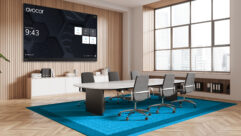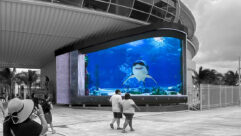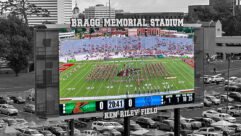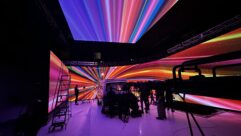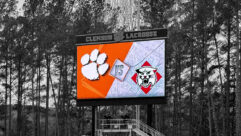
Technology Showcase: Large-format LED Displays
Apr 1, 2005 12:00 PM,
By Jay Ankeney
Improved displays take their place in everyday life.
Charts

Panasonic’s Astrovision in New York’s Times Square.
Over the past decade, light-emitting diodes (LEDs) have gained much in brightness and color fidelity and the image-processing systems empowering their displays have become very sophisticated. So much so, that today large-format LED displays are regularly seen presenting moving video images in stadiums, shopping malls, and on road-sides.
Essentially, an LED is a positive/negative-junction semiconductor diode that emits a monochromatic light. (See Diagram 1.) The first commercially viable LEDs were developed in the 1960s by combining three primary elements: gallium, arsenic, and phosphorus (GaAsP) to obtain a 655nm red light source that by today’s standards would be considered fairly low in intensity. Improvements were made throughout the ’70s, and a major development came in the late ’80s with the introduction of indium gallium aluminum phosphide (InGaAlP) as the luminescent material. This allowed colors including yellow, green, and orange to be produced with greater brightness using the same basic technology, simply by adjusting the size of the energy band gap. In the mid-’90s, the most difficult hue of the color spectrum was achieved — blue. Today, blue LEDs are constructed from gallium nitride (GaN) and silicon carbide (SiC). This breakthrough opened the door for the new generation of large-format, full-color LED video screens that has become so prevalent.
The most elaborate of these displays are called “spectaculars” and usually involve multiple LED panels, irregular shapes, and often other display technologies, such as neon tubes. The first modern spectacular, the huge Good Morning America sign on the ABC Building in New York’s Times Square, was installed on Sept. 13, 1999.
Modern LEDs offer a far greater luminance/power consumption ratio than other display technologies, and many proponents claim they will soon replace the common light bulb in everyday use.
Large-format LED displays are usually made up of combined individual panels to create their overall shape. They’re differentiated by widely varying resolutions, defined by the total number of vertical and horizontal pixels (dots that form the picture) that they possess. A combination of the source material, the processing technology creating the image, and the distance between pixels (called “pixel pitch,” which manufacturers often use to identify their product models) determines the resolution apparent to the observer. Typically, pixel pitches for indoor screens are 3mm, 6mm, 10mm, 15mm, and 20mm. Pixel pitches for outdoor screens are 15mm, 20mm, 25mm, 30mm, and longer because they are intended for greater viewing distances.
There are two types of LED panels. Most indoor screens incorporate surface-mount device (SMD) panels, in which red, green, and blue diodes are mounted on a single chipset. Outdoor displays tend toward discrete LED arrays where a cluster of individually mounted red, green, and blue diodes are driven together to form what appears to be a full-color pixel.

Lighthouse Technologies’
P12-ER at Opening Day 2004 for the San Diego Padres .
The market research firm iSuppli has tracked the LED industry since 1995. In its “Large-Screen Displays 2005,” Senior Analyst Sanju Khatri reports that the worldwide market for LED video displays was valued at $639 million in 2004 and will reach $669 million in 2005. This market is expected to grow to $755 million in 2010. Unit sales will rise from 518,067 sq. ft. in 2004 to almost 1.2 million sq. ft. in 2010.
There are literally hundreds of companies producing LED systems worldwide, with more emerging from Asian markets every day. But here are the most interesting large-format LED video displays from the major players in our domestic arena.
Act One Communications made the LED video screens that greet visitors at the Las Vegas Mirage, Bellagio, and Treasure Island casinos, as well as Sea World in San Diego. The modular displays are powered by advanced virtual pixel technology and boast 200 percent more pixels than traditional LED displays. Capable of displaying 48-bit color processing, Act One displays present a palette of 281 trillion hues across a horizontal viewing angle of up to 150 degrees in the daytime and up to 170 degrees at night.
ANC Sports has been marketing the Smartvision LED screens as a joint venture with Saco Technologies for the past three years, focusing on the operational interface software and sales side of the equation. ANC Sports claims Smartvision screens are in more professional sports facilities than those of any other manufacturer. The screens also offer a wider range of pixel pitches than any other system — 3mm to 20mm for indoor, 10mm to 40mm for outdoor — and life expectancies of up to 150,000 hours. A year ago, ANC Sports switched from analog video inputs to SDI and DVI signal paths that can feed its modular LED screens with 8:8:8 color space video, resulting in a brilliance that makes them viewable from angles of up to 170 degrees.
Barco offers the SLite 10, SLite 14, and SLite 22 large-format video displays (the numbers represent the screens’ resolutions in millimeters). The SLite series is intended for ultra-large outdoor LED display installations and features Barco’s proprietary dual pixel technology. The technology increases the visual resolution of a display, turning the physical resolution of 28mm for the SLite 14 into a visual resolution of 14mm. Barco’s DLite 7 LED display, seen during Paul McCartney’s halftime performance at Super Bowl XXXIX, combines 7mm resolution with short viewing distances. The company’s flagship indoor LED display product, the ILite 3, has 3mm resolution ideal for a corporate lobby, with viewing angles of up to 145 degrees. The ILite series also comes in 8mm, 10mm, and 12mm resolutions.
Since BillBoard Video bought Multimedia LED last July, it can now claim to be the first company in the country to have been building LED displays for 25 years. It has built 26 of the 38 spectaculars in the Times Square district, including the widest high-resolution LED screen in the world for JPMorgan Chase. The company’s eVidia line of LED displays features live, high-resolution video capabilities with more than 4.4 trillion RGB colors and advanced anti-aliasing technology for optimized graphics. The eVidia iOi I/O controller can address a matrix of up to 3200×3200 pixels on modules that range from 6mm to 25mm in pitch.
With more than 1,400 displays installed worldwide, Daktronics was recently ranked by iSuppli as the world’s leading provider of LED video displays. Its ProStar VideoPlus line of displays offers pixel pitches from 3mm (the PS-3I) all the way up to 89mm from its Venus 7000 controller. Daktronics’ dedicated V-Link video technology features pixel processing of up to 4.398 trillion colors. The most impressive spectacular from Daktronics is the 23mm Coca-Cola display in Times Square. Its unique sculptural design curves in two dimensions, a first in the large-screen display industry.
The enhanced-resolution P12-ER indoor/outdoor LED panels introduced this year by Lighthouse Technologies use advanced digital processing with a 12.5mm dot pitch resolution to display more images, graphics, and text on 25mm panels. The P12-ERs are the first LED panels to combine the benefits of Lighthouse’s M4 color uniformity, 14-bit grayscale, and resolution-enhancing technology. The internal architecture of the onboard processor in each panel features Lighthouse’s proprietary technology, enabling a high-resolution screen with superior brightness (5000 nits) and a 140-degree horizontal viewing angle at an affordable price.

Daktronics ProStar in use during a Memphis Grizzlies game at the FedExForum.
Panasonic‘s Astrovision indoor/outdoor screens reproduce 1.7 billion colors with 10-bit color brightness. Proprietary technology enhances the apparent resolution by doubling the sampling rate and sharing picture elements between lines of four LED clusters. The screens come in two models — the AZ-LEO8OZ 16mm (8mm dot pitch) and the AZ-LE12OZ 24mm (12mm dot pitch) — and offer both front and rear service accessibility. Astrovision screens are compatible with NTSC and PAL and offer 720p/1080i as an option.
The Diamond Vision LEDerboard family of displays from Mitsubishi Electric Power Products is now capable of displaying true high-definition video images for greater resolution and contrast across a wider screen. North America’s largest indoor LED video screen, a $6 million AVL-ID8 (8mm) Diamond Vision display measuring 34’×110′, can now be seen onstage at Caesars Palace Colosseum in Celine Dion’s “A New Day” show. This high-resolution, 16mm SMD screen uses multiple digital screen controllers networked together to display multiple high-definition moving images simultaneously.
Philips Vidiwall, a business unit of Philips Electronics, offers the Delta 25-5000 outdoor display. The Delta 25-5000 features Philips Delta Pixel Matrix Technology (DPMT) and incorporates the Philips Delta-Nabla LED configuration with the DPMT image-resampling algorithm. The SmoothPix function electronically eliminates differences in brightness and color between LEDs. Anti-Solarisation Processing (ASP) removes the sparkling and color banding commonly seen in darker picture areas of LED displays.
With its new TechnoRainbow TR2006 6mm modular LED presentation system just released in January, Toshiba has introduced unique new display options to the U.S. market. The TR2006 can be built on a convex or concave surface, as well as a flat screen, while offering a 170-degree viewing angle. Its digital PRLC-1050 processor, which works with all of Toshiba’s LED screens, can be configured for any HDTV application. In addition, the company’s popular TR2010E, a high-brightness, 10mm modular screen system, has dual indoor/outdoor capability. All TechnoRainbow systems from Toshiba are built to ISO 9001 and 14001 standards.
White Way Signs started producing electrically illuminated displays in 1916 with the goal of bringing the same lighted signs to Chicago that were becoming popular on Broadway. Today, the company offers three full-color LED displays, each designated by its own pixel spacing: the WWS34mmC1, WWS25mmC1, and WWS16mmC1. The 34mm and 25mm are for outdoor installations, the 16mm for indoor use. Each display features a simple routed-aluminum face-mounting system with 90-degree twist-locks for the LED modules. White Way Signs has written its own Windows-based control software, called Rainbow, that can run all of its displays — from small configurations to large spectaculars.
YESCO Electronics, a division of Young Electric Sign and a producer of full-color LED video displays for sign application, is best known for its super-sized LED video displays. The displays range in size from 12’×35′ to 75’×150′, each custom-made to suit the user’s specific applications and design requirements. YESCO’s LED displays benefit from a proprietary sign operating system known as PrismView, which allows for the scheduling and routing of video clips or still messages minute by minute for up to two years in advance. YESCO is currently installing a giant new curved-face display for the new Wynn Las Vegas resort. The sign includes a 50’×135′ LED screen that will run a series of customized video and animation features for the new resort.
For More Information
Act One Communicationswww.actone1.com
ANC Sportswww.ancsports.com
Barcowww.barco.com
BillBoard Videowww.billboardvideo.com
Daktronicswww.daktronics.com
Lighthouse Technologieswww.lighthouse-tech.com
Mitsubishi Electric Power Productswww.diamond-vision.com
Panasonicwww.panasonic.com
Philips Vidiwallwww.philips.com/vidiwall
Toshibawww.technorainbow.com
White Way Signswww.whiteway.com
YESCO Electronicswww.yescoelectronics.com


